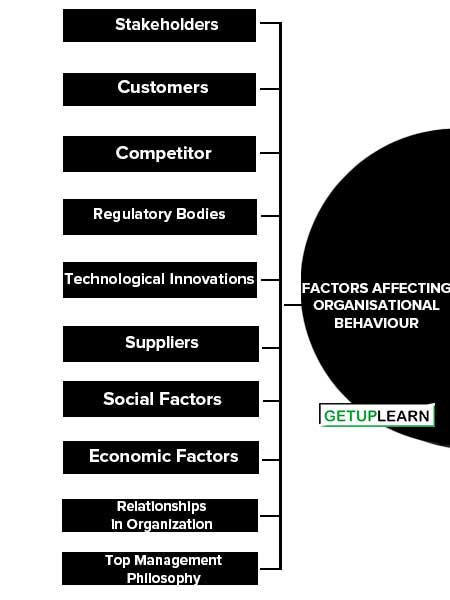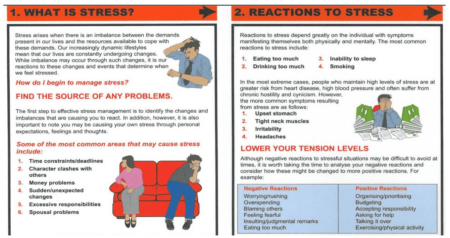Organisations exist in an environment that contains many forces that affect organizations. Organisations continuously interact with these external forces that play an important role in shaping the behaviours.
Table of Contents
Factors Affecting Organizational Behaviour
Moreover, a manager has to perform his tasks within the bounds of organisational processes and methods, while continuously interacting with other employees at various levels. So, there are certain factors in the internal environment, too, that affect organizational behavior.
- Stakeholders
- Customers
- Competitor
- Regulatory Bodies
- Technological Innovations
- Suppliers
- Social Factors
- Economic Factors
- Relationships in Organization
- Top Management Philosophy
- Structure

External Factors Affecting Organisational Behaviour
The external environment consists of the economic, political, and social conditions outside the organization. For example, companies depend upon efficient procurement of raw materials, components, government regulations, and a knowledgeable workforce. Probably the most important component of the external environment is the organization.
The following are external environment factors affecting organisational behaviour explained below:
- Stakeholders
- Customers
- Competitor
- Regulatory Bodies
- Technological Innovations
- Suppliers
- Social Factors
- Economic Factors
Stakeholders
These are the shareholders, customers, suppliers, governments, and any other groups with a vested interest in the organization. Stakeholders influence the firm’s access to inputs and ability to give outputs.
For example, how well the firm complies with the norms and fulfills the need of society, gives it a distinct competitive advantage and affects its right to operate in that environment. Some important components of the external environment that influence OB are discussed here in detail.
Customers
Organizations exist to fulfill some needs of customers. Customer choices are the deciding factor in the quality and quantity of goods or services that will be produced by organizations. This, in turn, is the major determinant of work schedules, technology, the requirement of a number of employees and their level of skills and qualifications, etc.
For example, if the demand for a particular product increases in the market, the firm will naturally have to increase production levels and may be required to start new retail outlets and new service centers. Employees may require training programs to learn skills to interact with customers and satisfy their needs.
Competitor
Competitors and an important component of a free market system. Competitors encourage (sometimes force) quality and price consciousness for firms.
A firm may initiate many changes like modification in strategies, improvement in processes (like communication, recruitment, performance appraisal, decision making, etc.), or change in structure (like creating a new department or creating new positions) to grow and move ahead vis-a-vis its competitors.
For example, many family-run businesses have professionalized their systems and processes in India in order to meet the competition in an open economy. Organizations try to get quality certifications like ISO and BIS certifications to ensure the customers about product/service quality.
Regulatory Bodies
Government regulatory bodies set norms and make rules for running a business. These agencies regulate the activities of organizations in five principal areas: consumer protection, investor protection, environmental laws, preservation of free market competition, and labor conditions.
Organizations have to make necessary changes in their policies, processes, and systems, sometimes in a big way, to meet these norms. For example, there are norms for environmental conservation and emission norms. To meet these norms organizations may be required to change their technology or may have to set up waste treatment plants.
Technological Innovations
Today, rapid technological changes and innovations are taking place globally. As a result of these, the nature of jobs is changing and the need for technical personnel is increasing. Hence, procurement of technically skilled employees is essential to match the changing job requirements.
Suppliers
Every organization needs some inputs in form of materials or components. They have to interact with a network of suppliers to obtain the inputs. According to Michael Porter as proposed in his ‘Five Force Model’, suppliers may exert a considerable bargaining power when:
- Suppliers are concentrated and well-organized;
- A few substitutes available for supplies;
- Their product is most effective or unique;
- Switching cost, from one supplier to another, is high,
- The Firm is not an important customer to Supplier
Social factors include prevailing attitudes, values, and ethics influencing organizations. Lifestyle is changing fast. The number of women in the workforce has increased, therefore companies must take care of their needs, like having crèche facilities, and transportation facilities. Many companies are providing flexible work timings, particularly in the IT sector.
Today, professionals fail to accept the autocratic style of management. The Millennial generation workers are said to share the following characteristics (Gerdes, 2006): Computer fluency, eagerness for feedback, teamwork orientation, desire for responsibility, and dislike for working long hours.
Businesses are moving towards a participative management style with more autonomy for workers. Organizations are adopting innovative methods of recognizing and rewarding employees. The focus is now on improving the quality of work-life. This has led to teamwork, job redesign, and other motivational practices to improve performance.
Economic Factors
Economic factors constitute indicators like Gross Domestic Product (GDP), rate of inflation, unemployment rate, economic cycles, and so on. Economic factors have an indirect impact on organizations.
For example, during a recession period, organizations may have to resort to retrenchment, lowering of production rate, stalling of expansion plans, and temporarily shutting down of plants. These actions have a far-reaching impact on organizational behavior.
Internal Environment Factors Affecting Organisational Behaviour
There are several factors in the internal environment of an organization that has a significant effect on behaviours. There are as follows:
Relationships in Organization
Inside the organization are numerous subsystems, such as processes (recruitment and reward systems), task activities (production, marketing), and social dynamics (informal groups). Individuals, dyads, and groups interact with each other in each of the processes, and for various tasks in the organization.
A manager is continuously interacting with his superiors, subordinates, and peers while fulfilling his various roles in the organization.
Top Management Philosophy
There are many organizational factors, including culture, top management values, and processes that have a profound impact on relationships and working in an organization. An example of an Organisational process is internal communication.
The culture of an organization is built on internal communication; this includes interpersonal relationships, newsletters, mission and vision statements policies, and so on. The way an organization interacts with customers and its public affects its image. All these, in turn, are determined by top management philosophy.
Structure
The structure is an internal factor that impacts the day-to-day operations of an organization. A firm may be sorted by departments and teams, or it might be structured such that employees work with outside contractors.
The structure impacts the number of employees hired, the levels of hierarchy, linkages, and the extent of coordination between various teams and departments. If a firm’s activities are outsourced, for example, the number of employees required will be less but that will also result in less control over the end product.
FAQs Section
What are the factors affecting organisational behaviour?
Stakeholders, Customers, Competitors, Regulatory Bodies, Technological Innovations, Suppliers, Social Factors, Economic Factors, Relationships in Organization, Top Management Philosophy, and Structure are factors affecting organisational behaviour.

